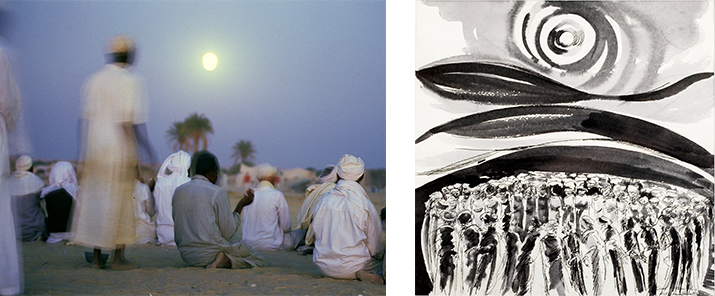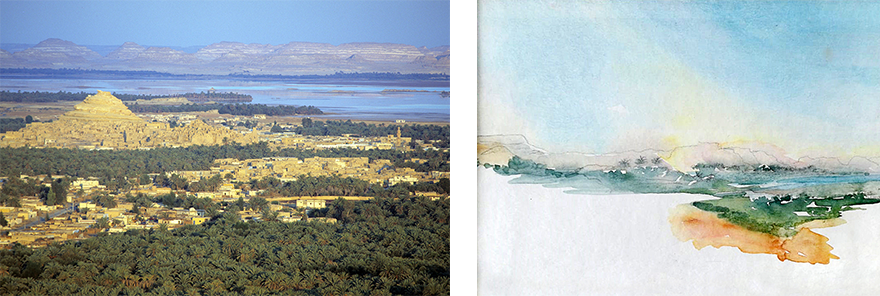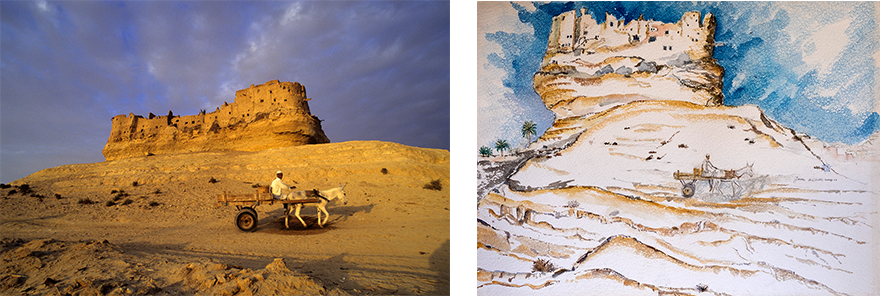
Sufi mulid in Siwa oasis held every year during the full moon in October. Watercolor by Rana Chalabi. Phot. Norbert Schiller
In the autumn of 1994, I traveled with fellow photographer and friend Patrick Godeau to the oasis of Siwa in Egypt’s Western Desert to witness and photograph the mulid or religious festival that takes place there every year under the first full moon in October. Siwa lies between the Qattara depression and the Great Sand Sea near Egypt’s border with Libya and is about 10 hours from Cairo by car. The people of Siwa are culturally and ethnically closer to the Berbers of North Africa than they are to the Egyptian who live along the Nile Valley. Even though they understand and speak Arabic, Siwans prefer to communicate amongst themselves in a Berber dialect. Up until the mid 1990s Siwa remained largely off the tourism grid partly due to government restrictions on foreigners traveling to remote areas of the country. Patrick, who had visited in 1983 using a special travel permit, immediately noticed the number of Egyptians from the Nile Valley who had settled in the oasis. To me, however, everything looked so different and I felt like I was in another country.

Siwa oasis with its date palm groves, salt lake and fortress town of Shali. Watercolor by Rana Chalabi, Phot. Norbert Schiller
Patrick and I were nearly the only foreigners attending the mulid because very few people had heard about it, and we had considerable freedom to move around and take photos. Presently, the mulid draws spectators from around the world and tour operators plan visits to coincide with the festivities. Besides photographing the celebration, we traveled to many of the villages in the oasis documenting the people, architecture, and the landscape.

The mud brick fortress town of Shali in Siwa oasis. Watercolor by Rana Chalabi. Phot. Norbert Schiller
I had read about another much smaller oasis close to Siwa called Qara that we wanted to visit. Qara had recently been opened up to foreigners but only visits were only allowed with a special permit a 24 hours window limit. The Qara oases was about a four-hour drive from Siwa, mostly off road following a dirt track through the desert. Everyone we spoke to suggested we hire a guide, but being somewhat stubborn we decided to take the trip alone. Since it had rained just prior to our departure, much of the dirt track had been covered by shallow pools of water around which we had to negotiate to stay on course. The most surreal event during the ride was running into a military checkpoint in the middle of nowhere where soldiers asked to see our travel permit before letting us continue onto Qara.
The inhabitants of Qara, a population of a few hundred, are descended from slaves who once served the people of Siwa. According to local historical accounts, only a limited number of people were allowed to live in Qara at one time due to harsh living conditions and lack of water. If a baby’s birth caused the numbers to rise above the acceptable limit, then one of the elderly villagers would have to leave. Today, residents of Qara subsist on harvesting dates and olives, the only two crops that can withstand the soil’s high saline contents.

The old fortress village in Qara oasis, which was destroyed by heavy rains in 1982. After the flooding the government build cement homes for the residence to live. Watercolor by Rana Chalabi. Phot. Norbert Schiller
We were warmly welcomed by Sheikh Hassan, the village elder, who told us many stories, including the time when the British bombed the oasis during WWII, when he was a child, believing that vats used to store olives were German petrol storage tanks. The sheikh also gave us a grand tour which included a visit to a water spring, most unusual rock formations in the surrounding desert, and the hilltop mud fortress which was home to all inhabitants of Qara until it was destroyed by heavy rains in 1982. The residents were moved to government-built cement houses, but the skeleton of the fortress still towers above the new settlement.
After our tour, Patrick and I proceeded to explore the oasis on our own. The next morning, we woke up at first light and captured unique photographs of farmers on donkey carts passing in front of the old hilltop fortress on the way to their fields.
After saying our goodbyes to Sheikh Hassan, we drove back through the desert carrying with us a special memory of this enchanted and still secluded oasis.
On my return to Cairo, I showed my photographs of Siwa and Qara to Syrian Lebanese painter Rana Chalabi, who is also a friend. As a practicing Sufi, she was particularly fascinated by the images I made of the mulid and decided to make her own pilgrimage to Siwa. Rana timed her visit with the Sufi celebration and afterwards she took the same journey that we did touring the Siwa oasis and Qara. Instead of documenting her trip with a camera, as I did, Rana brought along watercolors and painted what she witnessed on canvas.
The watercolors featured alongside my photographs in this story were part of a larger collection which was exhibited in Cairo in 1998. Both Patrick and I purchased a few of these works because they revealed a more spiritual aspect of Siwa and the mulid that was impossible for us to capture on film. To commemorate this trip taken a quarter of a century ago, I am featuring a few of Rana’s paintings and my photographs of the people and sites that we encountered.





Hello. What an inspiring sharing of the time you spent, as well as well as the artistic interpretations. Thank you.
Qara Water tank - Qara Water tank, Alminah, Al Minah 8147, Sakaka, Saudi ...
[…] The inhabitants of Qara, a population of a few hundred, are descended from slaves who once served the people of Siwa. According to local historical accounts, only a limited number of people were allowed to live in Qara at one time due to harsh living conditions and lack of water. شاهد المزيد… […]
Over 30 Years of Photographing Egypt: the Lessons and Story of Photographer Norbert Schiller | Egyptian Streets
[…] photograph was captured in 1994 by one of the most prolific news photographers in the Middle East for over 30 […]
Over 30 Years of Photographing Egypt: the Lessons and Story of Photographer Norbert Schiller ► Web Server - FlpDuniya.Com HOSTING
[…] photograph was captured in 1994 by one of the most prolific news photographers in the Middle East for over 30 […]
Over 30 Years of Photographing Egypt: the Lessons and Story of Photographer Norbert Schiller - News Africa Now
[…] photograph was captured in 1994 by one of the most prolific news photographers in the Middle East for over 30 […]
Over 30 Years of Photographing Egypt: the Lessons and Story of Photographer Norbert Schiller – Web Server – FlpDuniya.Com
[…] photograph was captured in 1994 by one of the most prolific news photographers in the Middle East for over 30 […]